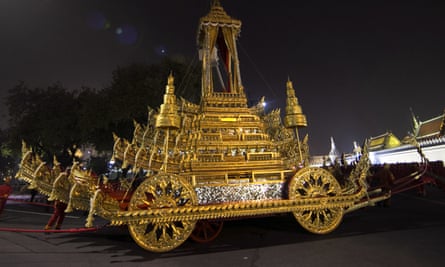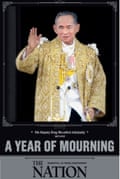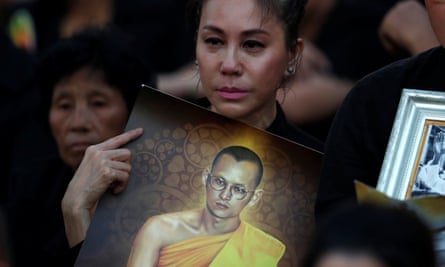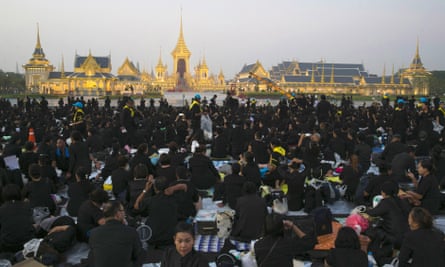Thousands of Thais dressed in black prostrated themselves and wept as the funeral urn for their former king Bhumibol Adulyadej, a man revered as a demigod who became the world’s longest-reigning monarch, was carried by chariot to his cremation pyre.
Despite monsoon-season downpours punctuated with searing subtropical temperatures, many mourners have spent days in tents hoping to be close to the official send-off for the ninth head of the Chakri dynasty on Thursday.
Hotels had been booked up weeks before the special day, which was declared a national holiday, and authorities prepared for 250,000 people to arrive.
King Maha Vajiralongkorn, the son of the former sovereign, performed the evening service at the three-tiered crematorium, which represents Mount Meru, the centre of the Hindu and Buddhist universe where it is believed Thai royals return after death.
The country’s top artisans have spent 10 months constructing the spectacular 50-metre-tall, golden crematorium. Its structure of nine gilded spires was adorned with images from mythology and the life of the king, including statues of his two favourite dogs.

A day-long grand procession of royal chariots and palanquins included the great victory chariot, a four-wheeled, 13-tonne vehicle that transported the king’s body to the crematorium, pulled by more than 200 men.
The junta had set aside 3bn baht (£70m) for the lavish funeral of a man viewed as a beacon of stability and peacemaker in a nation that has suffered repeated violent coups and counter-coups since his coronation in 1950.
Draconian lese-majesty laws make it illegal to criticise the monarchy, considered the world’s wealthiest, and the military generals currently in power who see themselves as royal protectors have ramped up prison sentences.
People feel genuine adoration for the man, who took the throne unexpectedly after his elder brother was shot in the head. He helped lift many in Thailand out of poverty through decades of philanthropy.
The cremation became a fixation for the Thai public, with Bangkok residents folding more than 10m flowers made of shaved sandalwood and placing them at temples. Its fragrance is believed to lead the souls of the dead to heaven.
One mourner, Montatip Chinnaprom, laid her flowers at a shrine on the outskirts of the old city after authorities closed entrance points to crowds. More than 100,000 had already entered the complex by early morning.

“I want to be as close to the cremation as possible,” said the 22-year-old student, dress in black shirt and skirt. “I loved king Rama Nine,” she added, referring to the monarch’s title.
Thai newspapers turned their websites monotone to express their grief.
Close to 80,000 security personnel were deployed, and drones were banned within a 19km radius. In fear of a mass influx, the government built 85 smaller replicas of the crematorium around the country where people can mourn.
Bangkok’s two metro services were free to use all day on Thursday and some food shops offered free meals. Jazz music composed by the king, who loved the saxophone, has been playing in public areas of the capital for weeks.
Queen Sofia of Spain, the former German president Christian Wulff, the UK’s Prince Andrew, and the Cambodian prime minister Hun Sen were some of foreign dignitaries who attended the cremation.

Television channels were ordered to reduce their colour saturation and not to air overly upbeat content in the lead-up to the cremation. About 10,000 7-Eleven convenience stores closed for the day.
Strict regulations handed out to reporters covering the event included a ban on long hair, earrings and moustaches for male journalists. “Unnatural hair colouring is not allowed,” they said.
The symbolic service – the actual cremation took place later on Thursday – ends the official mourning period, a year in which government officials and many Thais have only worn black.
Public shows such as masked plays, puppet shows and orchestral concerts began on Thursday evening, part of an extravagant five-day Buddhist ceremony including thousands of musicians and dancers.
“The king was very important for Thai people,” said Nutthapol, a librarian who said the monarch had donated money to the university where he is employed. “He worked for Thailand.”
His successor, Vajiralongkorn or Rama X, does not yet command the same affection as his father and has spent much of his adult life abroad, mostly in Germany. Since ascending to the throne, the 65-year-old - who had a long military career - has made amendments to the constitution that reinforce his powers.

The rite to send off the former monarch, known locally as the “father of all Thais”, is the emblematic end of his era and paves the way for the formal coronation of Vajiralongkorn.
“The cremation is a crucial ritual for Thailand,” said Paul Chambers of Thailand’s Naresuan University. “The December coronation of his son ... marks the official new beginning of the next dynasty. The father’s long and well-choreographed reign will be a tough act for the son to follow. As such, he will not escape the inevitable comparison.”
Since the king died on 13 October last year, more than 12 million people have visited his coffin at the Grand Palace.
The king’s ashes and bones will be returned to the palace on Friday and placed in the Emerald Buddha temple, the most sacred Buddhist site in Thailand.
